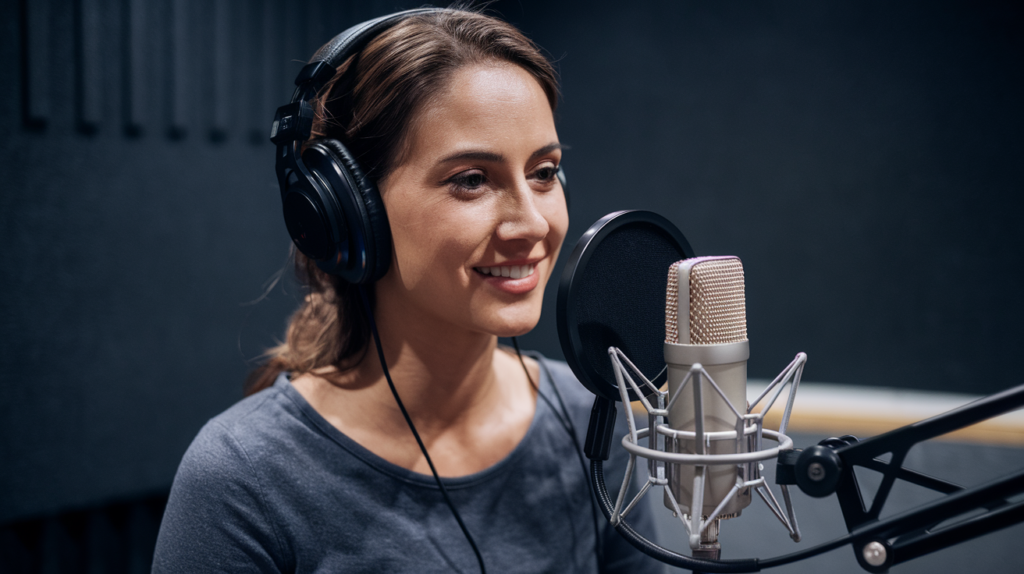Key Takeaways
- Cultural Connection: Choosing between Romanian and Moldovan voiceovers is essential for deep audience engagement, as each language carries unique cultural identities that resonate differently.
- Linguistic Nuances: While both languages share Latin roots, they differ in pronunciation and vocabulary. Romanian is often perceived as more melodious, whereas Moldovan reflects historical influences and regional dialects.
- Audience Preferences: Understanding your target demographic’s language preference can significantly enhance message perception and relatability. Opting for the familiar dialect fosters trust among listeners.
- Market Demand Analysis: With millions of speakers across both languages, analyzing market trends helps identify where to focus your voiceover efforts for maximum outreach and effectiveness.
- Industry Landscape: The Romanian and Moldovan voiceover markets are shaped by talented professionals who understand cultural nuances, ensuring high-quality audio content tailored to specific needs.
- Challenges in Selection: Navigating the complexities of linguistic differences and audience expectations requires careful consideration to achieve clarity, authenticity, and impactful messaging.
Ever wondered why choosing the right voiceover language can make or break your project? When it comes to Romanian and Moldovan, the decision isn’t just about preference; it’s about connecting with your audience on a deeper level.
Both languages share roots but carry unique nuances that can influence how your message is received. Whether you’re localizing content for a specific market or aiming for broader appeal, understanding these differences is crucial. Let’s dive into how selecting the right voiceover language can enhance your storytelling and resonate with listeners in ways you might not have considered before.
Overview of Voiceover Language Choices
Choosing the right voiceover language plays a critical role in your project’s success. When considering Romanian or Moldovan, you tap into unique cultural identities and dialects that can significantly enhance how your message resonates with listeners.
Both languages share similar roots, but they differ in pronunciation, vocabulary, and regional expressions. Romanian is often perceived as more melodious, while Moldovan carries its own distinct characteristics influenced by historical contexts. Understanding these nuances helps you select the best voice talent to convey your message effectively.
For instance, if you’re targeting an audience familiar with Moldovan culture, opting for a voice actor who speaks the language fluently ensures authenticity. This choice not only fosters connection but also builds trust among potential customers. Similarly, selecting a voice artist skilled in Romanian can elevate storytelling by engaging audiences on a deeper level.
Consider the demographic trends when making this decision. With over 24 million speakers of Romanian worldwide and approximately 3 million in Moldova, choosing either language opens doors to diverse markets. Aligning your content with the appropriate voiceover language enhances both reach and impact.
Ultimately, whether you opt for a vibrant Romanian tone or a rich Moldovan accent depends on your target audience’s preferences and expectations. Prioritize clarity in conveying your message while ensuring it aligns with local culture—this strategy will make all the difference in how your project is received.
Romanian vs. Moldovan Voiceover
Choosing between Romanian and Moldovan voiceover can significantly influence how your message connects with the audience. While both languages share a common ancestry, they each carry unique characteristics that impact communication.
Historical Context
Romanian and Moldovan stem from the same Latin roots, but historical events shaped their evolution. Romania’s western influences led to a more standardized form of Romanian, while Moldova experienced Soviet rule, which introduced Russian elements into everyday language. This backdrop adds layers to their respective identities—understanding this history can guide you in selecting the right voice talent for your project.
Linguistic Differences
When it comes to linguistic nuances, differences emerge in pronunciation, vocabulary, and regional expressions. Romanian often possesses a melodious quality that enhances storytelling through its rhythm and intonation. In contrast, Moldovan reflects a blend of local dialects and Russian influences, giving it a distinct flavor that’s impactful for certain audiences.
If you’re considering voiceovers for marketing or media projects targeting specific demographics, keep these variations in mind. The choice of voice artist can either enhance authenticity or create disconnect based on cultural familiarity. Selecting an appropriate voice over actor who resonates with your target audience’s background fosters trust and engagement—something every project aims to achieve.
Understanding these aspects helps you make informed decisions about which language suits your needs best—whether it’s the vibrant tones of Romanian or the rich accents found in Moldovan.
Factors Influencing Language Choice
Choosing the right voiceover language matters significantly for your project. Several factors influence this decision, particularly when considering Romanian and Moldovan.
Audience Preferences
Understanding your audience’s preferences is crucial. If your target demographic identifies more with one language over the other, that choice can shape their perception of your message. For instance, a vibrant Romanian voice might resonate better with listeners who appreciate melodic tones, while a Moldovan accent could connect deeply with those familiar with its historical influences. Research shows that audiences often respond positively to content delivered in their native dialect or language variant, enhancing engagement and relatability.
Market Demand
Market demand plays an essential role in determining which voiceover language to choose. With a significant number of speakers for both Romanian and Moldovan, you tap into diverse markets by selecting the appropriate voice talent. Analyzing industry trends can reveal where demand lies—whether it’s for promotional materials targeting Romanian-speaking consumers or educational content aimed at Moldovan speakers. Aligning your voiceover choices with market needs not only maximizes outreach but also ensures your message resonates effectively across regional lines.
By considering these factors thoughtfully, you enhance the effectiveness of your messaging and foster deeper connections with your audience through curated voiceovers that truly reflect their identities.
Voiceover Industry in Romania and Moldova
The voiceover industry in Romania and Moldova offers unique opportunities for connecting with diverse audiences. Understanding the landscape of this market can help you make informed choices about your projects.
Key Players in the Market
Several key players shape the Romanian and Moldovan voiceover markets, including experienced voice artists, production studios, and clients seeking quality voiceovers. Many talented voice actors specialize in various genres, from commercial work to narration and character voices. You’ll find that these professionals often possess a deep understanding of cultural nuances, which enhances their ability to resonate with listeners.
Moreover, numerous production houses collaborate with skilled voice over talent to deliver polished audio content tailored to specific needs. This combination of expertise ensures that your projects benefit from high-quality recordings that effectively convey messages across different media platforms.
Trends and Developments
The trends within the Romanian and Moldovan voiceover industry reflect broader global shifts while maintaining regional uniqueness. Increased demand for localized content has led to a surge in the use of native speakers who bring authenticity to their performances. As businesses look to engage local audiences more meaningfully, incorporating culturally relevant language becomes essential.
Technological advancements also play a significant role in shaping this industry. The rise of remote recording technology enables seamless collaboration between clients and voice over artists regardless of geographical barriers. This flexibility not only streamlines project timelines but also widens your access to top-tier talent.
In addition, an awareness of social media’s influence on marketing strategies has prompted companies to explore innovative ways of integrating voiceovers into their campaigns—think engaging video ads or captivating e-learning modules featuring dynamic narratives delivered by skilled professionals.
By staying attuned to these trends and leveraging local talent’s strengths, you can enhance your projects’ effectiveness while ensuring they resonate deeply with target audiences throughout Romania and Moldova.
Challenges in Voiceover Language Selection
Selecting the right voiceover language presents several challenges, particularly when considering Romanian and Moldovan. You might find that both languages share similarities yet diverge significantly in cultural contexts. This complexity can make it tricky to pinpoint the most suitable option for your project.
Understanding audience preferences plays a vital role in this selection process. If you aim to connect with a specific demographic, recognizing whether they lean towards Romanian or Moldovan is crucial. The nuances of pronunciation and local dialects can affect how effectively your message resonates. For instance, if your audience appreciates the melodic quality of Romanian, opting for a voice talent with that background enhances engagement.
Another challenge lies in identifying the appropriate voice artist who embodies your project’s tone and intent. It’s essential to ensure that their delivery aligns with cultural expectations while maintaining clarity and authenticity. A voice over actor familiar with regional expressions will bring an edge to storytelling that captivates listeners.
Market demand also influences choices significantly. If there’s a rising need for localized content within certain industries, you’ll want to analyze trends carefully. Understanding where opportunities lie allows you to maximize outreach by selecting the most relevant voice over talent.
Navigating these challenges requires thoughtful consideration of linguistic differences and cultural implications between Romanian and Moldovan. By prioritizing these factors during selection, you enhance not only message clarity but also overall impact across various platforms—be it advertising campaigns or educational materials.
Tackling these challenges head-on ensures you choose the right approach tailored specifically for your target audience’s preferences and needs within the vibrant landscape of Romanian and Moldovan voiceovers.
Conclusion
Choosing the right voiceover language is crucial for your project’s success. Understanding the nuances between Romanian and Moldovan can greatly influence how your message is received. By selecting a voice that resonates with your target audience’s cultural identity you enhance authenticity and trust.
Keep in mind that both languages offer unique opportunities to connect with diverse listeners. By staying informed about market trends and demographic preferences you position yourself to make impactful decisions. Prioritizing clarity and cultural alignment ensures that your storytelling not only reaches but also resonates with those you aim to engage. Your choice of voiceover language can transform an ordinary project into a memorable experience for your audience.
Frequently Asked Questions
What is the main focus of the article?
The article emphasizes the importance of choosing between Romanian and Moldovan voiceover languages. It explores how this decision affects audience connection, message clarity, and storytelling effectiveness.
Why are Romanian and Moldovan considered distinct?
Although both languages share common roots, they have unique nuances in pronunciation, vocabulary, and regional expressions. These differences influence how messages are received by audiences.
How does language choice impact voiceover projects?
Selecting the right language can enhance cultural alignment with the target audience. This fosters authenticity and trust, crucial for effective communication in voiceover projects.
What trends affect the demand for Romanian and Moldovan voiceovers?
Demographic shifts towards localized content and increased market demand play a significant role. Understanding these trends helps identify where talent is needed most.
Why is understanding cultural context important in voiceovers?
Cultural context shapes audience perception. Recognizing whether a demographic leans towards Romanian or Moldovan can significantly enhance message resonance.
How do technological advancements influence the voiceover industry?
Technological innovations like remote recording facilitate collaboration between clients and artists, expanding opportunities to connect with diverse audiences across Romania and Moldova.
What role does social media play in marketing voiceovers?
Social media impacts marketing strategies by providing platforms for innovative integration of localized content into campaigns, enhancing outreach to target demographics effectively.
How should one choose between Romanian or Moldovan for a project?
Consider audience preferences, cultural identity, linguistic nuances, and market demand when deciding on a language to ensure your message resonates well.







